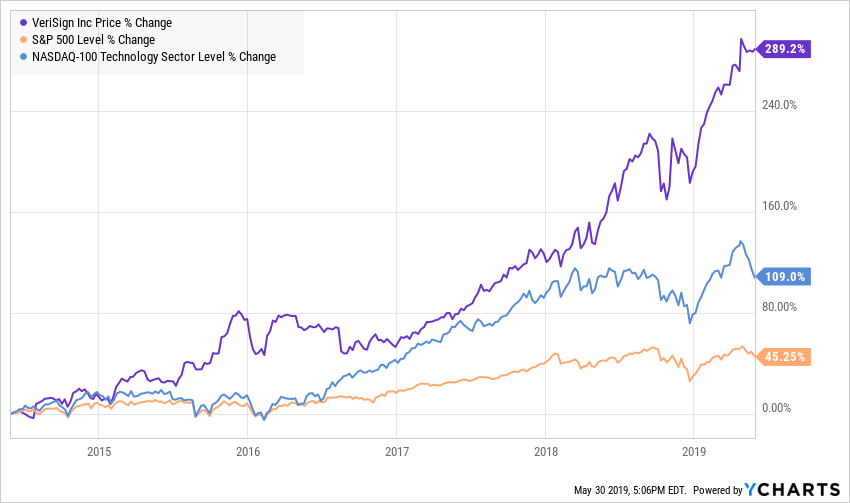PALM BEACH – There has been a lot of talk in tech and domain circles lately about the company “Verisign” (NASDAQ:VRSN), its obvious monopoly in the .com domain game, and it’s long list of subsidiaries, but things really started to heat-up back in October 2018 when the company managed to renew its “cooperative agreement” with the United States Government through the National Telecommunications and Information Administration (NTIA), minus long-standing pricing caps on one of its most powerful products and services; the registration and renewal of .com domain names.
In fact, things got so heated that the company went as far as threatening to put restrictions and price caps on the resale of domain names “in the aftermarket” or the “secondary market” so that domain investors, who they called “Domain Scalpers” can feel similar consequences, in retaliation to push-back on their own profits.
The fight is far from over, but time is on their side, and I predict that Verisign will eventually get their price increases on .com domain names, if not now, if not next year, eventually.
Here is why Verisign will inevitably get the price increases they seek:
First, one of the arguments is that Versign should not increase prices on .com domain names based on a “needs analysis”, whereas, Verisign already does very little work, for enormous profits, as it is, and larger profit margins are not necessary and worse, counterproductive to the public good. But the company is a for profit entity, with Warren Buffet’s BERKSHIRE HATHAWAY INC. as its largest shareholder, and the desire for increasing its profits belongs in the company’s DNA. (By the way, Berkshire’s got a pretty good track record placing bets on profits.)

Second, .com domain names are one of the least expensive domain names on the market, while they are in the greatest demand. With all these new gTLD domain names charging much higher registration and renewal fees, some unbelievably ridiculous prices, .com domain names are a bargain and remain on the clearance shelf at current prices. Think basic and simple “supply and demand” analysis, which leaves .com domain names defeating their own economic equilibrium. It doesn’t make sense. Why should the most desirable item on the list, be sold at the least price? I’d say, the “Wild West” pricing model of the new gTLD domain name extensions support an increase in .com prices near more than anything else I’ve seen thus far and nGTLDs were specifically mentioned in the Department of Commerce’s decision to remove the caps stating that “ccTLDs, new gTLDs and social media have created a more dynamic DNS marketplace, and as such, it’s appropriate for Verisign to have pricing flexibility.”
Third, Verisign’s biggest hurdle in gaining the ability to increase prices has already been accomplished with the renewal of the cooperative agreement, again, approved by the U.S. Government. With most small business owners maintaining a single domain name, would paying an extra dollar or so (per year) warrant a battle between ICANN and Verisign on a minimal increase? For what, to save businesses a dollar or two per year? Remember, no one cares about the “investors”, the “speculators”, the “domainers” or as Verisign put it, the “scalpers” in the mix who hold hundreds or thousands of domains. That argument will hold little wait, and the vast majority of consumers at large won’t care much either; just ask any business owner you know what precautions they’ve taken in preparation to spend $11 per year instead of $10; or even $13, instead of $11, if a price increase takes place. Nothing will be your answer. In fact, you’ll probably be asked why you even proposed such a nonsensical question.
Price increases are part of the world in which we live and work; we experience it every day. It might not always come in the form of a price increase either; sometimes it will be hidden in a product or service decrease. Have you noticed some of your favorite foods, particularly at the supermarket, have shrunk in size in recent years? Maybe five brownies in that brownie bag instead of six? They didn’t have to raise the price to increase profits; they just decreased the portion.
Not easily accomplished with a domain name.
The bottom line is, as much as I would like to pay the least possible, just like anyone else, to believe things which are highly desirable or in their highest demand, will not inevitably increase in cost, is simply unrealistic.
What say you? Have an opinion? Feel free to put it in the comments section below, that’s what it’s there for.

About The Author: John Colascione is Chief Executive Officer of Internet Marketing Services Inc. He specializes in Website Monetization, is a Google AdWords Certified Professional, authored a ‘how to’ book called ”Mastering Your Website‘, and is a key player in several Internet related businesses through his search engine strategy brand Searchen Networks®

 *** Here Is A List Of Some Of The Best Domain Name Resources Available ***
*** Here Is A List Of Some Of The Best Domain Name Resources Available ***
A dollar this year, a dollar next year, a dollar the year after that. It all adds up. Then restrictions removed and before you know it there’s premium pricing on higher-quality domains, Maybe $500 a year for a top quality name like other new gtld’s? Maybe $2500 Once you open that door, where does it end?
Keep in mind their increases are limited to 4 or 6 year intervals.
John, you respectively need to check your work, this is an incorrect assumption on your part. their increases are not limited to 4 or 6 years.
Please give us the details. I believe prices could be raised at every contract renewal, if you know something different, please detail it here.
Pretty sure it was a price rise in 4 out of every 6 years like they had about 10 years ago, so inevitably they will raise prices in year 1,2,3,4 then two years of no price rises, then another 4 price rises etc.
dotcom should cost $5 / year, every other extension less than $3.
Then eventually they will be free if they are not careful. ICANN and Veriisign should understand the implications of over-reach when domain names could someday be declared a public need and “right”.
The propagation of broadband and growth of the internet are taking on incredible momentum to reach every part of the planet. Not everyone can afford a domain name on this planet. One can see that someday everyone will want a piece of that prosperous pie.
Raising prices will have the opposite effect on the growth of personal ownership of the web. When a society wants access to something, pricing barriers are frowned upon by governments. The masses and voters will decide an non-profit organization like ICANN would abide by its stakeholders mandate to be bottom-up and keep domain names accessible and entry prices down..
Never going to happen. Domains are not and will not be considered a public need and “right”. – If anything should be a public need or right, it would be the Internet itself, and there is no signs of that happening; ISPs, telecoms, etc, are making way too much money on Internet connections for any of that nonsense. But having a connection to the Internet is indeed becoming a ‘necessary service’, from banking, to healthcare, etc – yet the Internet, as far as I know, isn’t being considered for categorizing it as a utility, and even if so, certainly not a free utility. How about free water, sewer, electricity? Not happening. Everything is online, but consumers are expected to maintain their own connection. Having an Internet address, or a premium easy to find one for that matter, won’t become a right in any of our lifetimes or even our children lifetimes, if ever.
> If anything should be a public need or right, it would be the Internet itself, and there is no signs of that happening
Are you sure about that? Some Scandinavian countries have already made internet access a “basic right” for their citizens. With the society drifting towards inevitable robotization – delaborization, more and more countries in the world are going to adopt that.
Very doubtful in the U.S.
And is it (basic right) Free, or is it (basic right) a requirement for it be provided in a minimum speed?
Either way, still do not see it being realistic that ISPs (Verizon, Comcast, etc) will loose this ‘billable’ item.
Entire net neutrality debate is based on ability to charge for different levels of service, types of connections, speed, etc.
Its free in Finland, since like 2009 or 2010.
When there is enough “public pressure”, the US will most likely go the same route more or less (since its not a kind of thing you can label “evil” to fight it). Like GDPR has seriously affected plenty of American websites (actually, the whole world).